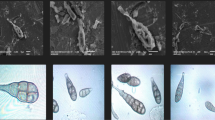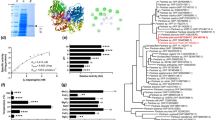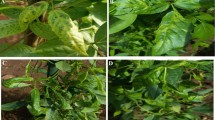Abstract
DURING the three years ending 1961, Peronospora tabacina Adam. has spread from north-western Europe east to the U.S.S.R. and Turkey and south to Algeria and Tunisia. The evidence1 indicates that this extensive distribution has been brought about by dissemination of the thin-walled, almost hyaline conidia that are produced in very large numbers. I have found up to 750,000 conidia per cm.2 of infected leaf surface, while Corbaz2 records twice this number. The effectiveness of conidia in initiating infections in previously free areas depends, inter alia, on their ability to survive during transfer. Survival (viability) on glass slides to which water is afterwards added to obtain germination is favoured by low temperatures and low relative humidities3, but with this procedure germination is extremely variable. More recently, Cruickshank4 and Shepherd5 have shown that reliable data on germination of conidia can be obtained on agar.
This is a preview of subscription content, access via your institution
Access options
Subscribe to this journal
Receive 51 print issues and online access
$199.00 per year
only $3.90 per issue
Buy this article
- Purchase on SpringerLink
- Instant access to full article PDF
Prices may be subject to local taxes which are calculated during checkout
Similar content being viewed by others
References
Centre de Co-operation pour les Recherches Scientifiques Relatives au Tabac. Rep. Fifth Meeting Groupe de Travail Peronospora (1961).
Corbaz, R., Rev. romande Agric. Vitic. Arborii, 16, 101 (1960).
Angell, H. R., and Hill, A. V., J. Coun. Sci. Indust. Res. Austral., 4, 181 (1931).
Cruiekshank, I. A. M., Austral. J. Biol. Sci., 14, 58 (1961).
Shepherd, C. J., Trans. Brit. Mycol. Soc., 45, 233 (1962).
Cruickshank, I. A. M., Austral. J. Biol. Sci., 11, 162 (1958).
Author information
Authors and Affiliations
Rights and permissions
About this article
Cite this article
HILL, A. Longevity of Conidia of Peronospora tabacina Adam.. Nature 195, 827–828 (1962). https://doi.org/10.1038/195827a0
Issue date:
DOI: https://doi.org/10.1038/195827a0



